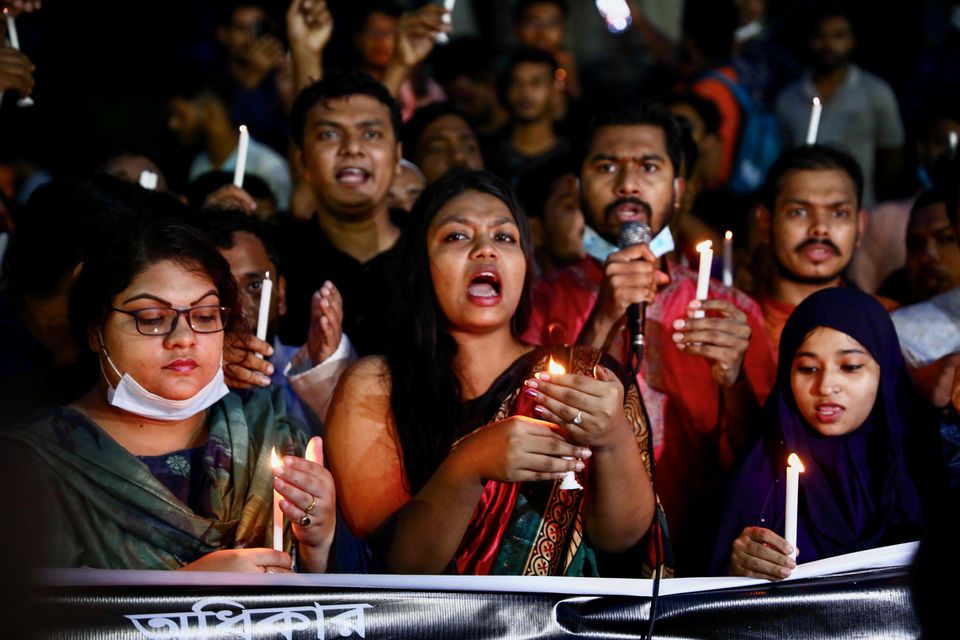For centuries, Durga Puja has been celebrated across the subcontinent as the biggest religious festival of the Hindu community. However, violence on Bangladeshi Hindus has been going on for years, and this year’s Durga Puja saw the worst of religious intolerance as multiple puja mandaps across the country were vandalised, leaving 11 Hindus dead.
A picture of the Quran placed at the feet of a Hindu deity sculpture was what instigated the mass violence in the first place. Upon further investigation, it was revealed that the perpetrator was actually a Muslim. But by that time, the damage had been done as mobs of outraged Muslims unleashed hell on Hindus all across the country. Mandaps, temples and idols were destroyed in Cumilla, Chittagong, Sylhet, Bandarban and Cox’s Bazar. 20 Hindu houses in Rangpur were set on fire following a supposedly offensive status that had apparently hurt the religious sentiments of the Muslims.
Unfortunately, circumstances like these are not an anomaly. In fact, religious intolerance has become quite a common phenomena in recent years, with violence on the minority increasing over time. Disrupting and vandalizing festivals celebrated by the followers of minor religions is nothing new. In the last few years, there have been quite a few instances of violence being inflicted upon non-Muslims, particularly on the Hindu community. In a country where people of different religions are supposed to live in peace and harmony, what is the contributing factor that’s pitting people against each other?
Religious Extremism
Bangladesh has had her fair share of religious extremism ever since her independence in 1971. According to Wikipedia, since 1971, the Hindu population has steadily declined, accounting for 8.96 percent of the total in 2011. Amnesty International claimed in 2013 that the growth of more openly Islamist political formations in Bangladesh throughout the 1990s had resulted in many Hindus being harassed or attacked, and that a sizable number had fled to India. A frighteningly large group of Muslims in this country believe that all Hindus must be expatriated, and these people will go to any length to implement their beliefs. In most cases, their methods include violence and savagery. A prime example of this would be the attack on Hindus across the country following the verdict of war criminal Delwar Hossain Sayeedi. The then vice-president of the Jamaat-e-Islami, was condemned to death by the International Crimes Tribunal on February 28 2013, for war crimes committed during the 1971 Bangladesh Liberation War. Following the sentencing, Jamaat-e-Islami workers and its student branch Islami Chhatra Shibir assaulted Hindus around the country. Hindu properties were robbed, Hindu homes were burned to ashes, and Hindu temples were desecrated and burnt.
False Sense of Religious Superiority
In a country where 89.1% of the population identify themselves as Muslims, it’s no wonder that blind faith in and little knowledge about religion create a false sense of superiority. This is also known as Religiocentrism, where a person is convinced that their religious views and beliefs are superior to that of any other religion. In this case, religiocentrism in muslims has contributed to the sufferings of minor religious people of Bangladesh.
This complex is formed at a very young age, when children are not capable of taking decisions on their own accord and they stick to the norms that their parents or guardians teach them.
Local religious preachers
Religious preachers, commonly known as Pirs, actively use their string of blind followers to spread hatred and misinformation against minorities. While not all local preachers actively promote religious superiority, there is still a large number of said preachers out there whose messages play a big part in inflaming, be it directly or indirectly, religious sentiments.
Stigma and superstitions
Social stigmas and superstitions play a huge role in hatred against followers of minor religions. Even to this day, there are Muslim parents who warn their children to stay away from Hindus, labeling them as bad company. There is also this age-old superstition that children are taught that red ants bite because they are Hindu, black ants are good and harmless because they are Muslims. The hatred against Hindus has gone to the point where people will associate animals and insects with religion just to try and prove their fickle arguments.
Fun Fact: Black ants do bite. So do Muslims.
Social Media
Social media has given everyone a platform to express their views and voice their opinions online. While on one hand this has its positives, this is also a quick and easy way to spread misinformation without facing repercussions. A very recent case of this was witnessed in Rangpur this year. An angry mob of extremists in Rangpur burnt down more than 20 Hindu homes after a rumor spread that a youth from the community had written a Facebook status insulting Muslims’ religious sentiments. In November 2020, a similar incident took place where at least 3 Hindu houses were burnt down following a rumor of a Facebook status that had apparently hurt the religious sentiments of the local Muslims. In 2014, at least 28 Hindu homes were vandalized in Bakhsitarampur village, Homna upazila, Cumilla, in an incident sparked by rumors that Prophet Muhammad had been defamed in Facebook posts by some Hindus. There are countless other cases of incidents like these that have been happening over the years. Some go unnoticed by the authorities, while some are brought under the light. Needless to say, religious extremists have quite mastered social media as a weapon to insinuate injustice upon Hindu minorities.
Religious intolerance
The Hindu community in Bangladesh is no stranger to religious intolerance. Between 2013 and 2016, there was a series of deadly attacks on a number of secularist and atheist bloggers, publishers, homosexuals and religious minorities like Hindus and Buddhists. By the 2nd of July 2016, 48 individuals had been killed in similar assaults, including 20 foreign nationals. Blogger Avijit Ray was stabbed to death by a gang of extremists at the exit of the Ekushey Book Fair, the largest annual book fair held in our country. Ahmed Rajib Haider, Asif Mohiuddin, Ananta Bijoy Das are some of the many who tragically lost their lives. The most horrifying account of religious intolerance in Bangladesh till date is the Holey Artisan attack in 2016, which took the lives of 24 individuals hailing from Bangladesh, Italy, India and Japan. This cold-blooded act was carried out by a group of young militants who believed they would be rewarded a place in heaven by murdering non-believers.
No matter how much we try to ignore the matters at hand, we cannot escape the blame for what’s happening right in front of our eyes.
If strict punishments were imposed since the very first attack, these incidents would not be increasing in number by the year.
At this rate, this country does not seem a safe place for anyone who is not a Muslim. While the perpetrators of the recent events have been brought under custody, there is still a lot for people of blind faith to unlearn in order for them to be more tolerant. Simply punishing the criminals would do nothing but induce more fear and hatred among the extremists, and their beliefs would still remain the same. The government has decided to remove Islam as the state religion following the recent incidents, but that has sparked even more outrage among the Muslims across the country. To prevent the biased beliefs and hatred from seeding into people’s minds, people must start with treating religious minorities as human beings.
Promoting human rights, diversity, and a global citizenship culture in schools
Students should be introduced to tolerance, respect for human rights, and tolerance for diverse cultures, genders, faiths and lifestyles as examples of intercultural understanding and a global citizenship ethic. Education is crucial in developing this global citizenship ethic. Many religious schools are unregulated, and it is not always clear whether their curriculum promotes global citizenship and human rights or if they preach conservative sectarianism, which eventually leads to radicalization. So, the standardization of school curricula (even in religious institutions) can be undertaken in order to prevent pupils from becoming radicalized.
Use social media to promote religious tolerance
To challenge the narrative employed by radical groups to persuade individuals to join their ranks, a communications strategy must be proactive rather than reactive to extremists’ alluring rhetoric. Creating an online interactive forum for people supporting creative ways to inclusion, human rights promotion, social cohesion and tolerance, gender equality, and women’s empowerment; and reach out to and engage in discourse with dissatisfied groups and individuals The voices of women, youth, religious leaders, as well as victims and survivors, are crucial in this strategy.
Collaborating with religious preachers
Religious preachers, organisations and leaders have a big impact on shaping their followers’ beliefs. Combating violent extremism requires a sophisticated knowledge of the role of religion, ideology, and identity, as well as their effect on individuals, communities, and institutions. It is also critical to refute the increasing notion that religion is the root cause of violence; the issue is to manipulate religious politics and obsessive ideologies. As a result, religious leaders carry a special obligation to assist in the prevention of violent extremism. They can establish a counter-narrative to violent extremism, as well as more tangible local and community-level initiatives that might be implemented through networks of religious groups and institutions. The regional context must be considered.
The answer to violence is not violence. People must unlearn what they have been taught for generations.
The false sense of religious superiority must be eradicated, instances of extremism must be dealt with quickly and effectively. One must not believe everything they see on the internet, as it is the easiest platform to spread misinformation and lies. This leads to violence. Maybe then, religious violence will come to an end and this country will finally be a safe space for people of all faiths.






















